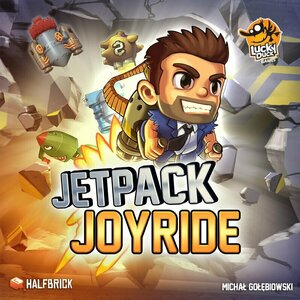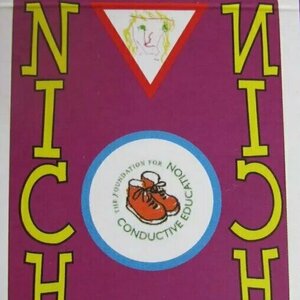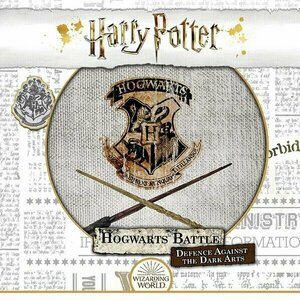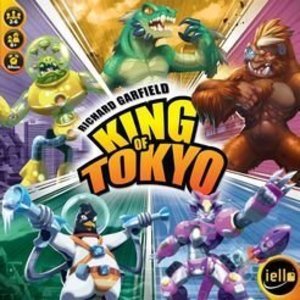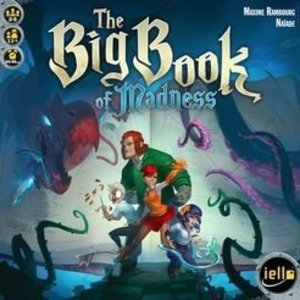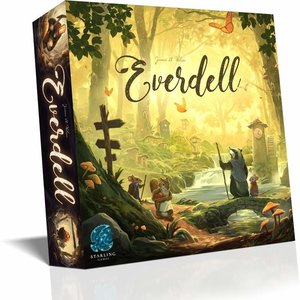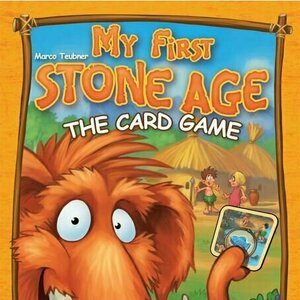Search
Search results
Purple Phoenix Games (2266 KP) rated Jetpack Joyride in Tabletop Games
Jan 8, 2020 (Updated Jan 8, 2020)
It should come as no surprise that I love to play board games. Hence my involvement in this wonderful group! But besides board games, I also enjoy my fair share of video games too. These two worlds of gaming occasionally collide when a classic from one realm is transferred over to the other! Is the adaptation as fun as the original, or does it leave much to be desired?
Originally a mobile game, Jetpack Joyride follows our main character, Barry, as he attempts to escape a top-secret lab with a stolen jetpack! He must avoid being hit by zappers, annihilated by lasers, and blown away by missiles in the process. If Barry succeeds, he escapes with not only the high-tech jetpack, but also with as many gold coins and other top-secret gadgets as he can get his hands on! So the risk is definitely worth the reward. But if Barry is unable to escape, he will face the consequences for his unauthorized joyride… In all honesty, I had never heard of Jetpack Joyride before I Kickstarted the board game version, so I downloaded it on my phone to see how it plays. Do you remember Flappy Bird? The mobile version of Jetpack Joyride is kiiiinda like that, but more exciting and way less infuriating. It’s free to download in the App Store and Google Play Store, so check it out if you’re interested! Anyway, back to the board game version. The premise is the same as the app – you have to create a path for Barry to use for his escape from the lab, utilizing the gadgets available to you and collecting gold coins on your way.
DISCLAIMER: We are using the Kickstarter Deluxe version of the game. We do have the expansions from the KS campaign, but will not be using those for this review. Also, we do not intend to cover every single rule included in the rule book, but will describe the overall game flow and major rule set so that our readers may get a sense of how the game plays. For more in depth rules, you may purchase a copy from the publisher directly or from your FLGS. -T
Jetpack Joyride is a real-time game of tile placement in which players are racing to see who can complete their run (path through the lab) the fastest. The game lasts for 3 runs, and points are earned throughout all runs. To setup, each player receives a set of 4 lab sector cards and sets them on the table in front of them in numerical order, 1-4. Three mission cards (cards that score points at the end of the run) are revealed and available for all players. Players may also have gadgets, available only to them, to help score extra points. When a run begins, all players grab translucent polyominoes (like matte versions of bits from Blokus) from the common pool and place them on their lab cards to create an unbroken path through the lab. There are specific placement restrictions that I will leave for you to discover in the rulebook. The game has no set time limit for each run, but it is a race to complete a path before your opponents. At the end of the run, points are tallied for completed missions and gadget cards. Easy, right? Here’s a small twist – before starting the next run, all players pick up their lab cards and pass them to the player on their left. So each run, players are looking at new cards and must find new paths through the lab! New mission cards and gadgets are revealed before subsequent runs as well. The player with the most points at the end of all 3 runs is the winner!
Jetpack Joyride is a fast-paced, exciting, and surprisingly strategic game that keeps all players engaged and entertained. And that’s what I love about it. First of all, real-time games are always high-energy, at least in my opinion. It’s nearly impossible to stay calm and collected when you’re literally racing against your opponents! Jetpack Joyride is definitely not a passive game, and there’s so much action and excitement that you sometimes forget you’re literally just laying tiles on cards. The next thing I love about this game is how deceptively strategic it is. Laying tiles to form a legal path across cards is not complicated, but doing so while also trying to earn extra points by completing missions (like placing 3 tiles of the same shape in a row, for example) adds a strategic element that you don’t expect. You’re not only trying to finish your run the fastest, but you’ve also got to fulfill the requirements for multiple mission and gadget cards too. One misplaced tile could decimate a run for you, so you’ve always got to be thinking several tiles in advance.
Going along with that, another neat thing about Jetpack Joyride is that all players are drawing tiles from a common pool. There is a finite number of tiles, and a specific number of the different shapes, so if the shape of tile you need is gone from the pool, you’re outta luck! You have to think and move quickly, otherwise you might get knocked out of a run, and that costs you valuable end-game points. For such a simple game, Jetpack Joyride also has a lot of variability. All lab cards are double-sided, and can be mixed and matched in any combination, as long as they are in a numerical set of 1-4. There are so many possibilities, chances are you won’t ever play with the same card combo twice….and if you do, chances are you won’t remember it 😛 All of these aspects elevate this game from a simple party game to a strategically fun game that can be played with any player count.
Overall, I think Jetpack Joyride is great. After my first play, I rated it a 4+, but after a few more I’ve changed my rating to a 5. As you can see from our scores above, Travis and our guest judge Luke enjoyed it as well. It’s a nice, light game that can be used as a filler between heavier games, or as a main-event game all on its own. Definitely a game I will use with newer gamers, and the strategic side will keep me coming back for more. I think Jetpack Joyride will get a lot of playtime from me, and it was worth my investment on Kickstarter. Purple Phoenix Games gives it a jet-powered 15 / 18.
Originally a mobile game, Jetpack Joyride follows our main character, Barry, as he attempts to escape a top-secret lab with a stolen jetpack! He must avoid being hit by zappers, annihilated by lasers, and blown away by missiles in the process. If Barry succeeds, he escapes with not only the high-tech jetpack, but also with as many gold coins and other top-secret gadgets as he can get his hands on! So the risk is definitely worth the reward. But if Barry is unable to escape, he will face the consequences for his unauthorized joyride… In all honesty, I had never heard of Jetpack Joyride before I Kickstarted the board game version, so I downloaded it on my phone to see how it plays. Do you remember Flappy Bird? The mobile version of Jetpack Joyride is kiiiinda like that, but more exciting and way less infuriating. It’s free to download in the App Store and Google Play Store, so check it out if you’re interested! Anyway, back to the board game version. The premise is the same as the app – you have to create a path for Barry to use for his escape from the lab, utilizing the gadgets available to you and collecting gold coins on your way.
DISCLAIMER: We are using the Kickstarter Deluxe version of the game. We do have the expansions from the KS campaign, but will not be using those for this review. Also, we do not intend to cover every single rule included in the rule book, but will describe the overall game flow and major rule set so that our readers may get a sense of how the game plays. For more in depth rules, you may purchase a copy from the publisher directly or from your FLGS. -T
Jetpack Joyride is a real-time game of tile placement in which players are racing to see who can complete their run (path through the lab) the fastest. The game lasts for 3 runs, and points are earned throughout all runs. To setup, each player receives a set of 4 lab sector cards and sets them on the table in front of them in numerical order, 1-4. Three mission cards (cards that score points at the end of the run) are revealed and available for all players. Players may also have gadgets, available only to them, to help score extra points. When a run begins, all players grab translucent polyominoes (like matte versions of bits from Blokus) from the common pool and place them on their lab cards to create an unbroken path through the lab. There are specific placement restrictions that I will leave for you to discover in the rulebook. The game has no set time limit for each run, but it is a race to complete a path before your opponents. At the end of the run, points are tallied for completed missions and gadget cards. Easy, right? Here’s a small twist – before starting the next run, all players pick up their lab cards and pass them to the player on their left. So each run, players are looking at new cards and must find new paths through the lab! New mission cards and gadgets are revealed before subsequent runs as well. The player with the most points at the end of all 3 runs is the winner!
Jetpack Joyride is a fast-paced, exciting, and surprisingly strategic game that keeps all players engaged and entertained. And that’s what I love about it. First of all, real-time games are always high-energy, at least in my opinion. It’s nearly impossible to stay calm and collected when you’re literally racing against your opponents! Jetpack Joyride is definitely not a passive game, and there’s so much action and excitement that you sometimes forget you’re literally just laying tiles on cards. The next thing I love about this game is how deceptively strategic it is. Laying tiles to form a legal path across cards is not complicated, but doing so while also trying to earn extra points by completing missions (like placing 3 tiles of the same shape in a row, for example) adds a strategic element that you don’t expect. You’re not only trying to finish your run the fastest, but you’ve also got to fulfill the requirements for multiple mission and gadget cards too. One misplaced tile could decimate a run for you, so you’ve always got to be thinking several tiles in advance.
Going along with that, another neat thing about Jetpack Joyride is that all players are drawing tiles from a common pool. There is a finite number of tiles, and a specific number of the different shapes, so if the shape of tile you need is gone from the pool, you’re outta luck! You have to think and move quickly, otherwise you might get knocked out of a run, and that costs you valuable end-game points. For such a simple game, Jetpack Joyride also has a lot of variability. All lab cards are double-sided, and can be mixed and matched in any combination, as long as they are in a numerical set of 1-4. There are so many possibilities, chances are you won’t ever play with the same card combo twice….and if you do, chances are you won’t remember it 😛 All of these aspects elevate this game from a simple party game to a strategically fun game that can be played with any player count.
Overall, I think Jetpack Joyride is great. After my first play, I rated it a 4+, but after a few more I’ve changed my rating to a 5. As you can see from our scores above, Travis and our guest judge Luke enjoyed it as well. It’s a nice, light game that can be used as a filler between heavier games, or as a main-event game all on its own. Definitely a game I will use with newer gamers, and the strategic side will keep me coming back for more. I think Jetpack Joyride will get a lot of playtime from me, and it was worth my investment on Kickstarter. Purple Phoenix Games gives it a jet-powered 15 / 18.
Purple Phoenix Games (2266 KP) rated Niche in Tabletop Games
Mar 3, 2021
I have a gamer confession to make and I am not sure how it will be received. Perhaps it isn’t a gamer confession at all. I will let you be the judge. I am not a fan of Sudoku. There! I said it, and I stand by it. I find it tedious and far too intelligent a game for me. However, if someone would just dumb it down enough for me to get it, I may actually enjoy it. Oh wait, Andy Hopwood did that for me already? Hot dog!
Niche is a puzzly abstracty Sudoku-y card sheddy game for two to seven players that can be played in as few as 10 minutes. In it players attempt to shed their hand and score the most points by adding cards to established lines of cards. As with most of Andy Hopwood’s games, though, there is a twist.
DISCLAIMER: We were provided a copy of this game for the purposes of this review. This is a retail copy of the game, so what you see in these photos is exactly what would be received in your box. I do not intend to cover every single rule included in the rulebook, but will describe the overall game flow and major rule set so that our readers may get a sense of how the game plays. For more in depth rules, you may purchase a copy online or from your FLGS. -T
To setup the dealer will shuffle the deck and, well, deal out seven cards to each player. The cards not dealt form a deck and from this deck a starter card is flipped to the table. Setup is complete and the game may now begin!
On a turn each player will need to perform three steps: Select, Place, Score. When Selecting a card from their hand the player will need to observe the last played card. This card will essentially inform the player of what CANNOT be played. For example (per the photo above), if a yellow triangle was just played, then the next card played can be NEITHER yellow nor a triangle. So from their hand the active player will select a group of cards that can be played this turn and choose one to add adjacently to the most recently played card.
The player then must Place their card such that they do not add the same card to the line that already exists within the line. For an example here (per the photo below), the most recently played card is a blue circle. In hand are two blue squares, a yellow square, and a red square. As the previous card is blue the only choices left are the yellow and red square. However, the card played previous to the blue circle was a yellow square, so that leaves our player with only one choice: the red square connected to the blue circle. Now, the player could actually use the yellow square, but would need to place it below the blue circle forming the beginning of a new line. I will explain why that is a less strategic play.
When players perform the third step in a turn, Scoring, they will count up all cards in the lines extended by their card, both vertically and horizontally. In our previous example the red square continues a line of two cards so their score for that placement is three. Should they place the yellow square below they will only score two as they have added onto only one card. Fans of Azul will be familiar with this scoring system. Players are expected to keep track of their own scores each turn.
Should a player not have any legal plays using cards in their hand they must pass, and await their next turn. Play continues in this manner of players performing these three steps in a turn until a player sheds their entire hand of cards. All other players will have one more chance to play one card to score points. Players add up all the points they have scored throughout the game and the player with the most points is the winner!
Components. This is a deck of cards in a tuckbox. The cards are all fine quality, and the iconography could not be much clearer. I have zero qualms with the components here.
Gameplay is super quick and puzzly, with a great weight for its type of game. This will not be a centerpiece title of the game night, but will offer filler style gameplay for gamers mulling about or waiting for the next game to begin. I enjoy the simplicity of the rules coupled with the puzzly and thinky nature of each turn. Obviously the name of the game is scoring points, so you want to add to an already-long line instead of having to begin a new off-shoot somewhere, but it is near impossible to anticipate what other players will place on their turns. Therefore, more strategic players will find either solace or frustration from the more tactical style of play here.
I do want to mention that this game was originally designed for an event benefiting The Foundation for Conductive Education in the UK. Quote taken from the BGG profile for Niche: “The game aims to promote and support The Foundation for Conductive Education. This method works with children and adults who have conditions such as Cerebral Palsy, Stroke, M.S. or Parkinsons, helping them to lead more independent lives.” I know this organization holds a special place in the designer’s heart and I just wanted to take a moment to give a shout-out to this amazing organization and this amazing person who created a game for the benefit of others. I applaud both entities, and hope for much success.
That said, Niche is a game that can be played with any type of gamer in almost any situation. It takes up little table space (at most nine cards in a line) and is rules-light. Purple Phoenix Games gives this one an extended 8 / 12. If you are a fan of Sudoku and would like to explore a little card game that gives this reviewer the same vibe (but infinitely more fun) then I urge you to grab a copy of Niche. Not only will you be purchasing a good little game, but your purchase also goes toward furthering an organization that is doing very important work in the UK. And if you would like to feel very smart, play Niche with me sometime and watch me struggle to play the right card.
Niche is a puzzly abstracty Sudoku-y card sheddy game for two to seven players that can be played in as few as 10 minutes. In it players attempt to shed their hand and score the most points by adding cards to established lines of cards. As with most of Andy Hopwood’s games, though, there is a twist.
DISCLAIMER: We were provided a copy of this game for the purposes of this review. This is a retail copy of the game, so what you see in these photos is exactly what would be received in your box. I do not intend to cover every single rule included in the rulebook, but will describe the overall game flow and major rule set so that our readers may get a sense of how the game plays. For more in depth rules, you may purchase a copy online or from your FLGS. -T
To setup the dealer will shuffle the deck and, well, deal out seven cards to each player. The cards not dealt form a deck and from this deck a starter card is flipped to the table. Setup is complete and the game may now begin!
On a turn each player will need to perform three steps: Select, Place, Score. When Selecting a card from their hand the player will need to observe the last played card. This card will essentially inform the player of what CANNOT be played. For example (per the photo above), if a yellow triangle was just played, then the next card played can be NEITHER yellow nor a triangle. So from their hand the active player will select a group of cards that can be played this turn and choose one to add adjacently to the most recently played card.
The player then must Place their card such that they do not add the same card to the line that already exists within the line. For an example here (per the photo below), the most recently played card is a blue circle. In hand are two blue squares, a yellow square, and a red square. As the previous card is blue the only choices left are the yellow and red square. However, the card played previous to the blue circle was a yellow square, so that leaves our player with only one choice: the red square connected to the blue circle. Now, the player could actually use the yellow square, but would need to place it below the blue circle forming the beginning of a new line. I will explain why that is a less strategic play.
When players perform the third step in a turn, Scoring, they will count up all cards in the lines extended by their card, both vertically and horizontally. In our previous example the red square continues a line of two cards so their score for that placement is three. Should they place the yellow square below they will only score two as they have added onto only one card. Fans of Azul will be familiar with this scoring system. Players are expected to keep track of their own scores each turn.
Should a player not have any legal plays using cards in their hand they must pass, and await their next turn. Play continues in this manner of players performing these three steps in a turn until a player sheds their entire hand of cards. All other players will have one more chance to play one card to score points. Players add up all the points they have scored throughout the game and the player with the most points is the winner!
Components. This is a deck of cards in a tuckbox. The cards are all fine quality, and the iconography could not be much clearer. I have zero qualms with the components here.
Gameplay is super quick and puzzly, with a great weight for its type of game. This will not be a centerpiece title of the game night, but will offer filler style gameplay for gamers mulling about or waiting for the next game to begin. I enjoy the simplicity of the rules coupled with the puzzly and thinky nature of each turn. Obviously the name of the game is scoring points, so you want to add to an already-long line instead of having to begin a new off-shoot somewhere, but it is near impossible to anticipate what other players will place on their turns. Therefore, more strategic players will find either solace or frustration from the more tactical style of play here.
I do want to mention that this game was originally designed for an event benefiting The Foundation for Conductive Education in the UK. Quote taken from the BGG profile for Niche: “The game aims to promote and support The Foundation for Conductive Education. This method works with children and adults who have conditions such as Cerebral Palsy, Stroke, M.S. or Parkinsons, helping them to lead more independent lives.” I know this organization holds a special place in the designer’s heart and I just wanted to take a moment to give a shout-out to this amazing organization and this amazing person who created a game for the benefit of others. I applaud both entities, and hope for much success.
That said, Niche is a game that can be played with any type of gamer in almost any situation. It takes up little table space (at most nine cards in a line) and is rules-light. Purple Phoenix Games gives this one an extended 8 / 12. If you are a fan of Sudoku and would like to explore a little card game that gives this reviewer the same vibe (but infinitely more fun) then I urge you to grab a copy of Niche. Not only will you be purchasing a good little game, but your purchase also goes toward furthering an organization that is doing very important work in the UK. And if you would like to feel very smart, play Niche with me sometime and watch me struggle to play the right card.
“OMG when is Purple Phoenix Games gonna review another Harry Potter game??” We listened. So here is the next installment of our unofficial Harry Potter games series. In Harry Potter: Hogwarts Battle – Defence Against the Dark Arts (which I will gladly reduce to Defence throughout the review, even though my American English Spidey-Senses are all over that spelling), players will be playing through a duel in the classroom using spells, allies, and items to push back and stun their opponent. Have you got the wand strength to stand up to your rival?
Like I just mentioned, Defence pits two players against each other in a sparring scenario. Players will be drafting cards that represent Spells to sling, Allies to aid, and Items to help knock opponents off their balance. The winner of Defence is the wizard who can stun their opponent three times. Only then will they be able to stand a chance against their dark foes.
DISCLAIMER: We were provided a copy of this game for the purposes of this review. This is a retail copy of the game, so what you see in these photos is exactly what would be received in your box. I do not intend to cover every single rule included in the rulebook, but will describe the overall game flow and major rule set so that our readers may get a sense of how the game plays. For more in depth rules, you may purchase a copy online or from your FLGS. -T
To setup a game, follow the rulebook instructions to lay out the main duel board and its shuffled decks that will surround it. These include the Hogwarts deck (from which players will be purchasing cards to add to their discard piles), the Library deck (which includes only Books cards that add influence or the ability to draw the top card of the player deck), Hexes (which are placed directly in the opponent’s discard pile and must be dealt with first when in hand), and Banished cards. Each player will choose a House card and a matching mover token to be placed on the board. Likewise, each player will have a starting hand of seven Alohomora! cards, one Wand, one Cauldron, and one starter Ally: Owl, Toad, or Cat. Each player will shuffle their starting deck, drawing five for their starting hand. Determine the starting player and the duel may begin!
On a player’s turn they will first deal with any Hex cards they have acquired, following the instructions written on the card. Once cleared, the active player will play cards from their hand in any order they wish to gain Influence to purchase cards from the Classroom (market), Attack points to push back their opponent towards the Stun space, or Health points to move their own mover token one space closer to the Starting space on the board.
Cards that are purchased from the Classroom can be Items, Spells, or even Allies. Items and Spells typically provide Influence, Health, or Attack, and some will have House bonuses in addition to normal effects. In order to take advantage of the House bonus, a player will either need to be from the affiliated House, or have an active Ally belonging to the affiliated House. This is a new mechanic in this game and adds another layer of strategy to a player’s purchasing.
As wizards duel back and forth slinging Spells, recruiting and activating Allies, and using Items to push back their opponent, one wizard will be stunned. When this happens the players will reset their play areas by combining all of their cards they have in their possession. Shuffle the lot of them, draw another hand of five cards and reset their mover token back to the Starting space. The next round is ready to begin and the wizard who stuns their opponent thrice will be crowned champion! Or get an A for the day… or whatever the Common Core equivalent is nowadays.
Components. I have many great things to say about the components in this box and a couple little gripes. Gripelets, really. First gripe: the box comes with a cardstock sleeve. It is very cool and looks great, but it’s unnecessary and I find it keeps snagging on other boxes and such. Not a big deal, as I can always get rid of it, but that’s an opinion. Second, the board is very dark. It features a very dark purple (yay purple!) with black spaces upon which players move their tokens. The colors are very close under certain lighting and I wish there was even just a faint outline of the spaces in a white or gray. Lastly, and probably just me and the way I play, the Attack and Health trackers are almost completely unnecessary. I know you are supposed to take a token every time you “Gain” a Health or Attack point, but I always just keep track in my head thus negating the need for the tokens.
But onto the great. Literally everything else is great. I have always enjoyed the components in the original game, and as this one contains many of the same, I also enjoy these. The art style is interesting and pretty cool, and I really don’t mind screencaps as much as many others do. So for me, overall, I really enjoy the components here.
All in all I truly love this game. I am almost always in the mood to play Harry Potter: Hogwarts Battle, but it is cooperative and my wife doesn’t really enjoy the OG HP game. This one, however, she does enjoy because she can just flex on me and stun me into oblivion with her superior deckbuilding abilities. This one is quicker to setup and play, and holds a much smaller footprint. The mechanics are familiar without being totally duplicating, and I just love deckbuilders in general. So this one was bound to be a big hit with me from the start.
If you are looking for a great Harry Potter-themed deckbuilding game and are not completely sold on the bigger cooperative game, take a look at this much smaller two-player competitive title. Do try to take some of the cards with a grain of salt, as I am sure it is difficult to imagine having both Hermione and Draco as allies simultaneously, but it can happen in the game. Purple Phoenix Games gives this one a very enthusiastic 11 / 12. Just a word of caution, try not to Flipendo your table when you lose. It won’t end well.
Like I just mentioned, Defence pits two players against each other in a sparring scenario. Players will be drafting cards that represent Spells to sling, Allies to aid, and Items to help knock opponents off their balance. The winner of Defence is the wizard who can stun their opponent three times. Only then will they be able to stand a chance against their dark foes.
DISCLAIMER: We were provided a copy of this game for the purposes of this review. This is a retail copy of the game, so what you see in these photos is exactly what would be received in your box. I do not intend to cover every single rule included in the rulebook, but will describe the overall game flow and major rule set so that our readers may get a sense of how the game plays. For more in depth rules, you may purchase a copy online or from your FLGS. -T
To setup a game, follow the rulebook instructions to lay out the main duel board and its shuffled decks that will surround it. These include the Hogwarts deck (from which players will be purchasing cards to add to their discard piles), the Library deck (which includes only Books cards that add influence or the ability to draw the top card of the player deck), Hexes (which are placed directly in the opponent’s discard pile and must be dealt with first when in hand), and Banished cards. Each player will choose a House card and a matching mover token to be placed on the board. Likewise, each player will have a starting hand of seven Alohomora! cards, one Wand, one Cauldron, and one starter Ally: Owl, Toad, or Cat. Each player will shuffle their starting deck, drawing five for their starting hand. Determine the starting player and the duel may begin!
On a player’s turn they will first deal with any Hex cards they have acquired, following the instructions written on the card. Once cleared, the active player will play cards from their hand in any order they wish to gain Influence to purchase cards from the Classroom (market), Attack points to push back their opponent towards the Stun space, or Health points to move their own mover token one space closer to the Starting space on the board.
Cards that are purchased from the Classroom can be Items, Spells, or even Allies. Items and Spells typically provide Influence, Health, or Attack, and some will have House bonuses in addition to normal effects. In order to take advantage of the House bonus, a player will either need to be from the affiliated House, or have an active Ally belonging to the affiliated House. This is a new mechanic in this game and adds another layer of strategy to a player’s purchasing.
As wizards duel back and forth slinging Spells, recruiting and activating Allies, and using Items to push back their opponent, one wizard will be stunned. When this happens the players will reset their play areas by combining all of their cards they have in their possession. Shuffle the lot of them, draw another hand of five cards and reset their mover token back to the Starting space. The next round is ready to begin and the wizard who stuns their opponent thrice will be crowned champion! Or get an A for the day… or whatever the Common Core equivalent is nowadays.
Components. I have many great things to say about the components in this box and a couple little gripes. Gripelets, really. First gripe: the box comes with a cardstock sleeve. It is very cool and looks great, but it’s unnecessary and I find it keeps snagging on other boxes and such. Not a big deal, as I can always get rid of it, but that’s an opinion. Second, the board is very dark. It features a very dark purple (yay purple!) with black spaces upon which players move their tokens. The colors are very close under certain lighting and I wish there was even just a faint outline of the spaces in a white or gray. Lastly, and probably just me and the way I play, the Attack and Health trackers are almost completely unnecessary. I know you are supposed to take a token every time you “Gain” a Health or Attack point, but I always just keep track in my head thus negating the need for the tokens.
But onto the great. Literally everything else is great. I have always enjoyed the components in the original game, and as this one contains many of the same, I also enjoy these. The art style is interesting and pretty cool, and I really don’t mind screencaps as much as many others do. So for me, overall, I really enjoy the components here.
All in all I truly love this game. I am almost always in the mood to play Harry Potter: Hogwarts Battle, but it is cooperative and my wife doesn’t really enjoy the OG HP game. This one, however, she does enjoy because she can just flex on me and stun me into oblivion with her superior deckbuilding abilities. This one is quicker to setup and play, and holds a much smaller footprint. The mechanics are familiar without being totally duplicating, and I just love deckbuilders in general. So this one was bound to be a big hit with me from the start.
If you are looking for a great Harry Potter-themed deckbuilding game and are not completely sold on the bigger cooperative game, take a look at this much smaller two-player competitive title. Do try to take some of the cards with a grain of salt, as I am sure it is difficult to imagine having both Hermione and Draco as allies simultaneously, but it can happen in the game. Purple Phoenix Games gives this one a very enthusiastic 11 / 12. Just a word of caution, try not to Flipendo your table when you lose. It won’t end well.
Rikki Hammond (33 KP) rated King of Tokyo in Tabletop Games
Jun 4, 2019
Easy to teach (2 more)
Great at all player counts
Looks visually great
Games are over far too quickly sometimes (1 more)
Some cards are far too overpowered
Yahtzee With Monsters
Please note, this review is for the first edition of the game.
King of Tokyo is one of the first games I bought for myself, when I got back into board gaming years ago, and it's definitely a fantastic light filler game, that will appeal to all ages.
Players choose a monster, and then take it in turns rolling six custom dice up to three times (like Yahtzee,) to either attack other players, heal their own health, gain 1,2 or 3 victory points, or collect energy.
Once one player attacks another, they enter Tokyo, and gain an extra victory point for each turn they are in there, however, everyone else can attack you, and you can't heal, but your attacks hurt everyone else to counteract this. You can decide to exit Tokyo, which will put the last player who attacked you in there instead.
Energy is used to buy special cards that help you out in one way or another. This can be anything from allowing you to roll an additional die, to giving you an extra life if you are destroyed. Each card has a different energy cost to buy them, and generally the better cards cost more, although some cards cost very little, but can be very overpowered, which can throw a little imbalance in the game.
A player wins by either destroying all other monsters, or by gaining 20 victory points (although it's usually the former that occurs.)
King of Tokyo is a lot of fun, but sometimes the games can be over far too quickly, especially if someone gets lucky with the attack rolls and card purchases, and sometimes players can be eliminated early on, leaving them to sit and watch as the rest of the game is played.
Overall, I would recommend King of Tokyo to casual gamers, and those starting out in gaming, especially those with kids, as it's light, easy to teach, and fun to play.
King of Tokyo is one of the first games I bought for myself, when I got back into board gaming years ago, and it's definitely a fantastic light filler game, that will appeal to all ages.
Players choose a monster, and then take it in turns rolling six custom dice up to three times (like Yahtzee,) to either attack other players, heal their own health, gain 1,2 or 3 victory points, or collect energy.
Once one player attacks another, they enter Tokyo, and gain an extra victory point for each turn they are in there, however, everyone else can attack you, and you can't heal, but your attacks hurt everyone else to counteract this. You can decide to exit Tokyo, which will put the last player who attacked you in there instead.
Energy is used to buy special cards that help you out in one way or another. This can be anything from allowing you to roll an additional die, to giving you an extra life if you are destroyed. Each card has a different energy cost to buy them, and generally the better cards cost more, although some cards cost very little, but can be very overpowered, which can throw a little imbalance in the game.
A player wins by either destroying all other monsters, or by gaining 20 victory points (although it's usually the former that occurs.)
King of Tokyo is a lot of fun, but sometimes the games can be over far too quickly, especially if someone gets lucky with the attack rolls and card purchases, and sometimes players can be eliminated early on, leaving them to sit and watch as the rest of the game is played.
Overall, I would recommend King of Tokyo to casual gamers, and those starting out in gaming, especially those with kids, as it's light, easy to teach, and fun to play.
Purple Phoenix Games (2266 KP) rated The Big Book of Madness in Tabletop Games
Jun 12, 2019
Man, this game looks great! The components are really cool! The premise is excellent, and something that is somewhat underused! This is going to be amazing! We get to be Harry Potter and his friends tracking down baddies and using spells to squish them back in their book!
Except, it totally misses the mark for me. -100 points to Grifflepuffinclaw.
So here you are minding your own business at magic college, when you happen past The Big Book of Madness and its pages fly open, releasing monsters onto the campus. Being the heroes that you are training to become, you leap into action to use your spells to reign them back into the book and save the day… hopefully before lunch in the caf. (Purists, I know that’s not exactly the premise, take a cold shower.)
This game uses some clever mechanics, like a shared pool of spell cards that can be used on anyone’s turn to help them with their plans, deck building (which is my favorite mechanic), variable player powers, and a super-sweet book that is assembled while setting up. The shared pool is the best part of this game. You can send cards from your hand right into the shared pool of cards that are available to everyone on their turn, should they need them to defeat curses.
We are no strangers to co-op games, so this was an easy win in my head. But, for some unfathomable reason, my playmates refused to put cards into the shared pool. Y U NO HLAP MEH, FREN?? I am almost positive that the shared pool is the key to victory, but after several plays of this game, I don’t think any of us really want to try anymore. That being said, I have since gotten rid of this game and am excited to see what will fill its shoes as the next great-looking co-op with a shared resource pool. Sorry IELLO, I typically love your products.
Purple Phoenix Games gives The Big Book of Madness a big ol score of 8 / 12.
https://purplephoenixgames.wordpress.com/2018/12/10/the-big-book-of-madness-review/
Except, it totally misses the mark for me. -100 points to Grifflepuffinclaw.
So here you are minding your own business at magic college, when you happen past The Big Book of Madness and its pages fly open, releasing monsters onto the campus. Being the heroes that you are training to become, you leap into action to use your spells to reign them back into the book and save the day… hopefully before lunch in the caf. (Purists, I know that’s not exactly the premise, take a cold shower.)
This game uses some clever mechanics, like a shared pool of spell cards that can be used on anyone’s turn to help them with their plans, deck building (which is my favorite mechanic), variable player powers, and a super-sweet book that is assembled while setting up. The shared pool is the best part of this game. You can send cards from your hand right into the shared pool of cards that are available to everyone on their turn, should they need them to defeat curses.
We are no strangers to co-op games, so this was an easy win in my head. But, for some unfathomable reason, my playmates refused to put cards into the shared pool. Y U NO HLAP MEH, FREN?? I am almost positive that the shared pool is the key to victory, but after several plays of this game, I don’t think any of us really want to try anymore. That being said, I have since gotten rid of this game and am excited to see what will fill its shoes as the next great-looking co-op with a shared resource pool. Sorry IELLO, I typically love your products.
Purple Phoenix Games gives The Big Book of Madness a big ol score of 8 / 12.
https://purplephoenixgames.wordpress.com/2018/12/10/the-big-book-of-madness-review/
Dillon Jacoby-Rankin (202 KP) rated Everdell in Tabletop Games
Jan 18, 2020
Components (6 more)
Quality
Price
Game is expandable in future
Replayability
Theme
Artwork
Small text on special event cards because the card themselves are already small. (1 more)
Time can be alot if you have to teach new players.
My Favorite Game!
This game is hands down my favorite. Let's start there.
Players 1-4 Expands to 5-6 with future expansion
Ages 14+
Time 40-80 minutes. Definitely longer with more players especially if they are new to the game or worker placement in general. I played with 4 players and it took easily 150 minutes. Not complaining just with teaching and all it took longer than expected.
Components: These are full 3d pieces made of various materials. They all feel wonderful to hold and play with making collecting them for the game very satisfying.
Quality: The game is amazing in general and you can see the work that was put into the game. It was kick-started but you can tell there was a passion behind the game.
Price: The quality is worth it. And if you were ever unsure. Get the higher priced edition if possible. It will have more features like I believe metal coins for victory points as well as other content that are not in the base game like workers and cards for the solo game variant.
Expandable: The game has Pearlbrooke already out as well as 2 other Expansions being funded and at least a fourth one in the works because I read that they will not make a big box to put everything in, until the line is complete. And no big box yet. So a fourth expansion the look forward to for sure.
Replayability: Easily replayable as forest locations and special event cards will be different every time you play especially if you add some of the Expansions to your base game.
Theme: The idea of little woodland creatures collecting resources and building their own tiny cities is absolutely adorable and makes this game 100 times for fun and cute for me.
Artwork: The cards and board are fanominal. The art is so nice and cute.
Players 1-4 Expands to 5-6 with future expansion
Ages 14+
Time 40-80 minutes. Definitely longer with more players especially if they are new to the game or worker placement in general. I played with 4 players and it took easily 150 minutes. Not complaining just with teaching and all it took longer than expected.
Components: These are full 3d pieces made of various materials. They all feel wonderful to hold and play with making collecting them for the game very satisfying.
Quality: The game is amazing in general and you can see the work that was put into the game. It was kick-started but you can tell there was a passion behind the game.
Price: The quality is worth it. And if you were ever unsure. Get the higher priced edition if possible. It will have more features like I believe metal coins for victory points as well as other content that are not in the base game like workers and cards for the solo game variant.
Expandable: The game has Pearlbrooke already out as well as 2 other Expansions being funded and at least a fourth one in the works because I read that they will not make a big box to put everything in, until the line is complete. And no big box yet. So a fourth expansion the look forward to for sure.
Replayability: Easily replayable as forest locations and special event cards will be different every time you play especially if you add some of the Expansions to your base game.
Theme: The idea of little woodland creatures collecting resources and building their own tiny cities is absolutely adorable and makes this game 100 times for fun and cute for me.
Artwork: The cards and board are fanominal. The art is so nice and cute.
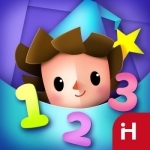
Math's Journey
Education and Stickers
App
Welcome to the magical world of mathematics! Math's Journey helps children aged 3-6 learn the basics...
Purple Phoenix Games (2266 KP) rated My First Stone Age: The Card Game in Tabletop Games
Apr 7, 2021
The Kids Table series from Purple Phoenix Games seeks to lightly explore games that are focused toward children and families. We will do our best to give some good insight, but not bog you down with a million rules…
My First Stone Age: The Card Game (that’s a mouthful) is a quick and easy card game that can be played by any child of any age assuming they have the attention span for it (mine didn’t the first couple times). It focuses on memory skills and set collection mechanics.
Setting up is easy. Shuffle the Hut Cards and give each player one. Shuffle the Goods Cards and deal nine face-down in a circle. Place the rest of the deck in the middle of the circle face-up. Plop Martin, the mammeeple (mammoth meeple) on or near one of the face-down cards and you’re ready to play!
The winner of the game is they who is able to build three huts first. Players can build huts by moving Martin around the circle clock-wise 1-4 spaces, collecting the card if it matches the players’ hut card, and then building the hut by discarding the goods used. Each turn players will be able to move Martin, flip a card to see if it matched their hut card, and build a hut. The game continues in this fashion until the winner has built their third hut!
This is a very light game that has very simple rules, and not a ton for the players to have to keep track of or remember. Perfect for young ones and not-so-young ones alike. We love the artwork on the cards and being able to move a large mammeeple around the table searching for fish or arrowheads. While the game is competitive in that there is a winner and therefore also losers, we mitigate that by saying that, “if I win then you get to tickle me, but if you win I get to tickle you!” That usually quells any upset youngsters pretty quickly.
We love this game and it is a great first step into gateway games that target older audiences. It is simple and quick, and a minimal investment for a good few minutes!
My First Stone Age: The Card Game (that’s a mouthful) is a quick and easy card game that can be played by any child of any age assuming they have the attention span for it (mine didn’t the first couple times). It focuses on memory skills and set collection mechanics.
Setting up is easy. Shuffle the Hut Cards and give each player one. Shuffle the Goods Cards and deal nine face-down in a circle. Place the rest of the deck in the middle of the circle face-up. Plop Martin, the mammeeple (mammoth meeple) on or near one of the face-down cards and you’re ready to play!
The winner of the game is they who is able to build three huts first. Players can build huts by moving Martin around the circle clock-wise 1-4 spaces, collecting the card if it matches the players’ hut card, and then building the hut by discarding the goods used. Each turn players will be able to move Martin, flip a card to see if it matched their hut card, and build a hut. The game continues in this fashion until the winner has built their third hut!
This is a very light game that has very simple rules, and not a ton for the players to have to keep track of or remember. Perfect for young ones and not-so-young ones alike. We love the artwork on the cards and being able to move a large mammeeple around the table searching for fish or arrowheads. While the game is competitive in that there is a winner and therefore also losers, we mitigate that by saying that, “if I win then you get to tickle me, but if you win I get to tickle you!” That usually quells any upset youngsters pretty quickly.
We love this game and it is a great first step into gateway games that target older audiences. It is simple and quick, and a minimal investment for a good few minutes!

Werewolf "Nightmare in Prison"
Games and Education
App
◆◇◆◇◆ Thank you for 6,000,000 DL! ◆◇◆◇◆ The werewolf game that is poplar in...
